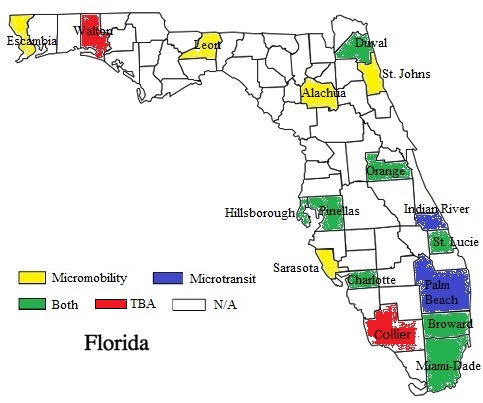
Project Manager: Gabe Matthews (Florida Department of Transportation)
Background
Microtransit and micromobility are gaining increasing attention around the world due to a huge advantage in satisfying people’s travel demands for the first/last mile that existing public transit cannot cover. With this consideration, some countries and cities, together with the vendors or providers of microtransit and micromobility services, have jointly designed and implemented a series of microtransit and micromobility programs to provide new transportation alternatives, particularly for the first/last mile.
Generally, microtransit is one new form of demand-responsive modes of transportation that can offer a highly flexible routing and/or scheduling of minibus vehicles shared with other passengers. This means that microtransit providers can build routes ad-hoc exclusively to only match each demand and supply and extend the efficiency and accessibility of the transit service. It is worth noting that possible pick-up/drop-off stops of current microtransit programs are still restricted to some specific locations and therefore they mainly provide stop-to-stop or curb-to-curb services. As some proponents argue conceptually, microtransit fits somewhere between private individual transportation and public mass transit. Overall, the main goal of different microtransit services is to expand a network’s geographic and demographic reach, usually serving populations that are low density, low income, and/or lacking some other reliable transportation options. Furthermore, microtransit has been proven with a huge potential in decreasing traffic congestion, spurring economic development, and reducing the amount of air pollution.
Different from microtransit vehicles, micromobility devices mainly refer to a range of small, lightweight vehicles operating at speeds typically below 25 km/h (15 mph) and driven by users personally. Initial definitions set the primary condition for inclusion in the category of micromobility to be a gross vehicle weight of less than 500 kilograms (1,100 lb). However, the definition has evolved to exclude devices with internal combustion engines and those with top speeds above 45 km/h (28 mph). The term evokes a transition like that of microcomputing where the miniaturization of transport modes for short journeys parallels the miniaturization of microcomputers for personal use. Nowadays, it is widely acknowledged that micromobility devices include bicycles, e-bikes, electric scooters, electric skateboards, shared bicycles, and electric pedal assisted bicycles, etc., This also creates another affordable mobility option for travelers, and meanwhile, it can bring enormous social benefits in promoting sustainability and active transportation, reducing auto parking demands and increasing recreational opportunities. More importantly, micromobility programs can efficiently complement existing transit service by offering “last-mile” connectivity and presented huge potentials in helping reduce traffic congestion and pollution by replacing automobile trips.
As the microtransit and micromobility programs are gaining great popularity, there is also no exception over many states of U.S. With this consideration, our research team has an intention to perform an inventory project gathering all forms of microtransit and micromobility programs in Florida, which is also the main objective of this project. Specifically, this project aims to form a full inventory of microtransit and micromobility in Florida, then map their geofenced service areas and identify their relationship, if any, with transit agencies. Therefore, this project can offer an intuitive and comprehensive understanding of what kinds of microtransit and micromobility programs have been implemented over the whole state of Florida.
Project Objectives
The objectives of this project are to inventory all forms of microtransit and micromobility in Florida, map the geofenced service areas and identify their relationship, if any, with transit agencies. Specifically, this proposed research project will address some fundamental questions such as:
(1) Which cities and counties have designed and implemented microtransit and micromobility programs in Florida, and how to integrate them into a complete statewide inventory including the following information:
- a. Type of relationship/contract for vendors and cities regarding each microtransit and micromobility program, for example, who are procuring agencies of microtransit.
- b. Type and number of micromobility devices, for instance, stand-on scooters, e-bikes, and bicycles, etc.
- c. Type of service apps and how to access the service regrading each microtransit and micromobility program.
- d. Cost for use, for example, how much it cost to use each microtransit/micromobility service.
(2) What are geofenced areas mapping and the corresponding service areas, as well as shapefiles, regarding each microtransit and micromobility program?
(3) What are the integrations of microtransit or micromobility services with public transit if any, for example, whether each program is payable through the transit agency, if there is an agreement between transit agency and each microtransit or micromobility program, and if the transit agency have a policy to implement the service.